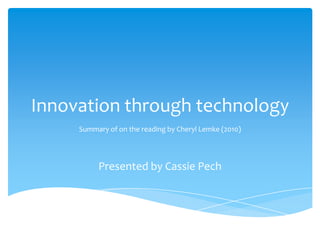
Innovation through technology: Based on the works of Lemke, C. (2010)
- 1. Innovation through technology Summary of on the reading by Cheryl Lemke (2010) Presented by Cassie Pech
- 2. Interesting statistics related to 21st century learning What do these statistics mean for educators? Innovation: The fuel for a knowledge-based economy Innovations: One- Visualisation, Two – Democratization of knowledge, Three – Participatory learning. So now what? Getting there from here. Discussion questions Overview
- 3. In this chapter Lemke introduces 3 important innovations of 21st century learning: Visualization – Making sense of things. Democratization of knowledge – The spread of knowledge/access to information digitally. Participatory learning – Students engaging in dynamic learning environments. Lemke (2010) provides a demonstration of ways technology permits greater balance between a visual approach and traditional language-based communication. Innovation through technology
- 4. 96% of 9-17 year olds embrace web 2.0 culture of social networking, blogging, twittering, GPS mapping or interactive gaming (National Board Association 2007) Youth typically spend 9 hours week outside of school using social networking and 10 hours watching TV Teens average 2899 text messages per month, 15 times the average number of voice calls (191) Emails and voice calls are now their “Father’s mode of digital communication not theirs” average of nine hundred thousand blogs are posted every 24 hours Over 2.5 billion tweets have been sent Over one hundred million users are logging into Facebook everyday Approximately 2.6 billion minutes globally are spent using Facebook daily, in 35 different languages THERE IS NO QUESTIONS THAT THE LINE BETWEEN OUR DIGITAL AND PHYSICAL LIVES ARE BLURRING! Interesting Statistics
- 5. We need to ensure that our students are ready to live, learn, work and thrive in this high-tech, global, highly participating world. There is a call to action for smart, innovative and informed leadership in 21st century learning. The more progressive educators are embracing web 2.0, however the majority are yet to act. So what does this mean for Educators?
- 6. Innovation is defined as a creative idea that has achieved sufficient social/ and or professional acceptance so as to become the impetus for ongoing ripples of creativity and change. (Drucker 2002) Innovation is an idea that has tipped and is viral, influencing the system within which it spreads. (Gladwell 2000) Innovation: The Fuel for a knowledge-based economy
- 7. People learn better from combining visuals with text and sound than through using either process alone. (Mayor and Mosco 2003) – Technology enables us to do this in a number of ways. Principles related to multimedia and modality: - use of multimedia improves student retention - students need to learn to interpret, think with and build simple/complex multimedia communications - students need to learn to become informed viewers, critics, thinkers and producers of multimedia -visual literacy is a critical component of what it means to be literate in the 21st century Innovation One: Visualisation
- 8. Develop students as informed consumers of information Engage students in thinking critically and creatively using visuals Engage students in communicating using visuals Note: Check out the links in this article – excellent tools to do this using technology. Strategies for teachers in using technology to capitalize on the power of visualization
- 9. Due to the internet the ecology of learning is evolving. People are informally learning based on personal, professional, family, work and community needs, interests or responsibilities. Schools needs to embed this informal and accessible style of learning. The democratizing of knowledge provides the opportunity for life long learning. In order for this innovation to enhance student learning, students need the opportunity to develop critical thinking, self-direction and information literacy at school. Innovation 2: Democratization of knowledge
- 10. Browsing the net Simulations (learning by doing) Learning objects (virtual manipulatives) Online courses/Online learning Strategies for teachers to embrace this innovation:
- 11. Today’s schools are focussed on individual acquisition of knowledge, student by student, despite the fact that, increasingly, society, community, and work emphasize teaming, collaboration and participatory learning. Students are naturally engaging with this form of learning – social networking, blogging etc. Innovation Three: Participatory learning
- 12. Emphasize and value the participation in groups Incorporate active online communities Embrace personal devices (smart phones, IPod touch etc.) Participate in live chats, exchange and comment on video, audio and text files Note: Jan – Senior Science Facebook example. See links for practical examples/online resources! Tips for teachers to implement participatory learning
- 13. So now what? Getting there from here How to embrace these innovations in YOUR school: School leaders must develop a culture of openness to change, risk taking. Metiri Group’s dimensions of 21st learning framework: A first step to gauge your schools readiness for 21st century learning. Metiri Group’s dimensions of 21st learning framework (2008): Vision systems thinking/leadership 21st century skills learning, 21st century learning environments professional competencies access and infrastructure accountability
- 14. Looking at the Metiri Group’s dimensions of 21st century learning framework, consider the readiness of your school for 21st century learning. Which sections require addressing? How might you address them? Which of the three innovations through technology do you feel your school is embracing? How are you doing it? What implications does embedding the 3 innovations discussed in the reading have for schools? Discussion Questions
- 15. Lemke, C. (2010). Innovation through technology pp. 243-273. In Bellanca, J. & Brandt, R. (Eds). 21st Century Skills: Rethinking how students learn. Bloomington:Solution Tree Press. Reference list